
About This Quiz
Walking through the woods, jungle, swamps or desert anytime soon? This quiz could save your life, or at least keep you from panicking if you get bitten by a snake that looks dangerous, but isn't. It has been estimated that in the United States alone, 7,000 to 8,000 people per year report bites from venomous snakes. Fortunately, with prompt medical care readily available in the U.S, only five of those people may die. However, if you're on the road less traveled and hiking through South America, Southeast Asia or sub-Saharan Africa, you'll want to memorize this quiz. Take it now, and find out if you're ready for the wilderness!
There is a morbid fascination many of us have with assassin snakes. Did you see the movie, "Snakes on a Plane,†with Samuel L. Jackson? Or the dozens of other killer-snake movies such as, "Tremors," "Slither" or "Anaconda?" One creepy, slithery, venomous snake is all you need to keep you awake at night. But if you're a herpetologist or a snake enthusiast, you may outshine other quiz takers by sssssscoring high on this snake screenshot quiz!

Similar to land snakes, the black-banded sea krait has scales, a forked tongue, and lidless eyes. It also breathes air. Because it spends the majority of its time under water, it differs from land snakes, however, having a short, flattened tail which propels it quickly when swimming.
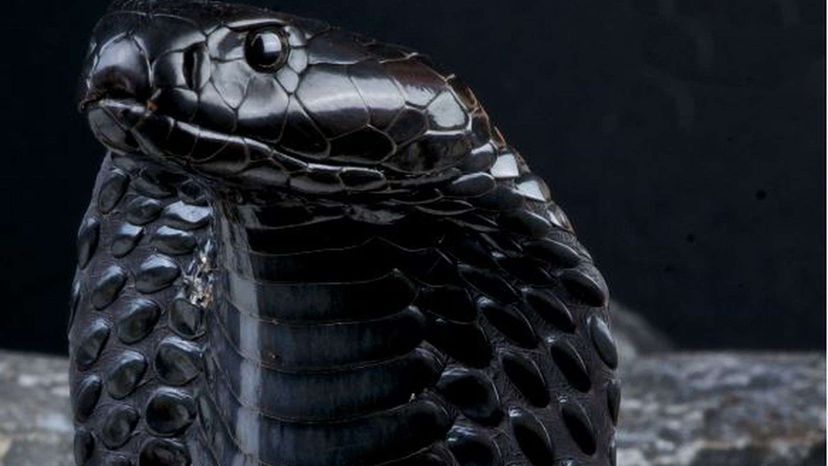
The black-necked spitting cobra doesn't always have a black neck. Sometimes it can be pure copper or olive brown, and sometimes it can have black and white stripes. It is a very adaptable snake that can thrive in different environments. Its bite is minimally lethal, with a mortality rate of 5-10% for untreated bites.

Infant coral snakes hatch from eggs laid by the female snake. Coral snakes do not give birth to live young like many of the other North American venomous snakes; which, we'll admit, is not common for reptiles, but only 70% of snakes lay eggs. At birth, coral snakes are seven inches long and are already at their full venomous potential.
Advertisement
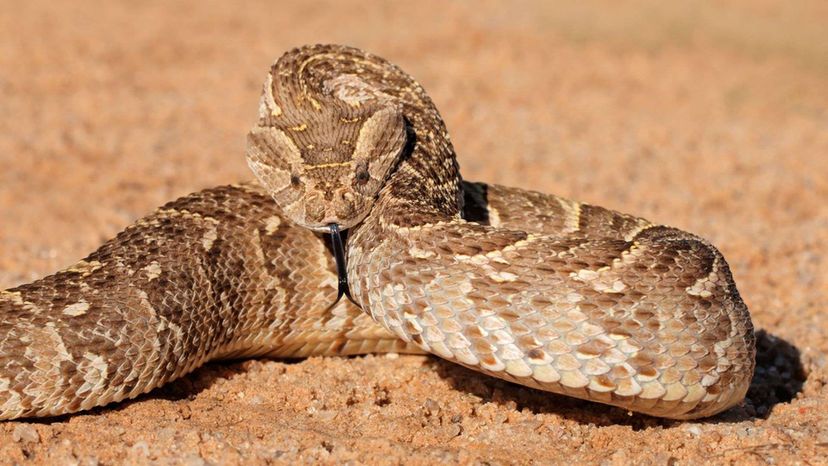
When disturbed, this snake will coil into a defensive S-shaped posture and hiss loudly. This snake, while not the most venomous in Africa, accounts for the highest number of snake bite fatalities on the continent. This is partly because they are very common, widespread and like to hang out in places that people walk.

Found in the warm waters of the Pacific and Indian oceans, the Yellow-bellied sea snakes require fresh water to survive, so they've adapted ways to consume it in their saline environment. It lives completely in water.

The intriguing look of a tiger rattlesnake comes from colors varying from bluish gray to lavender, or even buff-colored. Their sides and underbelly can be orange, pink or cream in color. They live in the United States of America and Mexico.
Advertisement

Horned vipers are ecologically important because they keep a number of rodents under control. They are a smaller snake variety, not normally growing longer than two feet. Despite their small size, they can survive 14 to 18 years in the wild!

The Mojave rattlesnake has the most potent venom of any rattlesnake in North America. Its venom is about 16 times more toxic than that of the sidewinder and surpasses even that of the tiger rattlesnake. It can be particularly aggressive to humans and is quick to defend itself if disturbed.

The forest cobra is the second largest species of cobra on Earth, measuring upwards of seven feet! When in captivity, they become very aggressive and dominating, perhaps due to their large size. They mostly live in central and western Africa.
Advertisement

The Indian krait, or common krait, is one of the four species in India that contribute to most of the snake bites in the country. If left untreated, the bite has a very high mortality rate of 70-80%. The Indian krait is relatively quiet and calm during the day, but more likely to bite at night.

Western brown snakes are found in Australia. Their aboriginal name, gwardar, means "go the long way around." This was probably advice on what to do if you ran into one of these. These snakes use a combination of constriction and venom to kill their prey.

Eastern green mambas live throughout large parts of the African continent. While scientists aren't certain how long they live in the wild, in captivity, they've been known to live up to 18 years. They mostly eat adult birds, eggs and small mammals, like rodents.
Advertisement

Caspian cobras are generally aggressive starting from a young age. They are great climbers and swimmers, especially when going after their prey. They are the most venomous cobra in the world.

The Mojave rattler is the most venomous rattlesnake in the world (although not the most venomous snake.) There is an antivenom available if you're unlucky enough to be bitten, and luckily, fatalities are fairly uncommon despite the nature of this snake's venom.

The western green mamba is native to West Africa. It lives in tropical and woody areas. The toxicity of its venom can vary tremendously, depending on where it lives and what it eats.
Advertisement

The Sind saw-scaled viper (also known as the eastern saw-scaled viper) is found mostly in Pakistan, India, Afghanistan and parts of Iran, the UAE and Oman. It lays eggs rather than giving live birth.
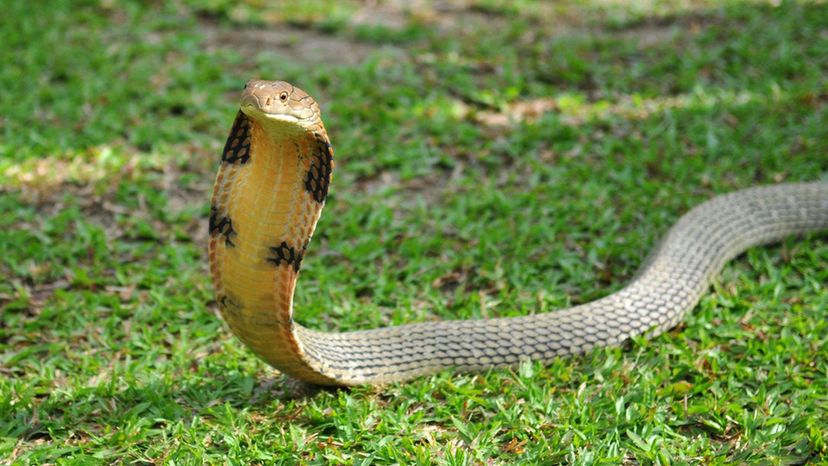
While not the world's longest snake, the king cobra is the world's longest venomous snake. The largest one ever found was just over 19 feet long, but they average closer to 12 feet. It mostly eats other snakes, and it swallows its prey whole.

The olive brown sea snake has a paddle-shaped tail that helps it swim. It's generally not aggressive towards people, unless it's provoked. The snake's venom helps it digest its prey because it contains enzymes that essentially pre-digest muscle tissue.
Advertisement
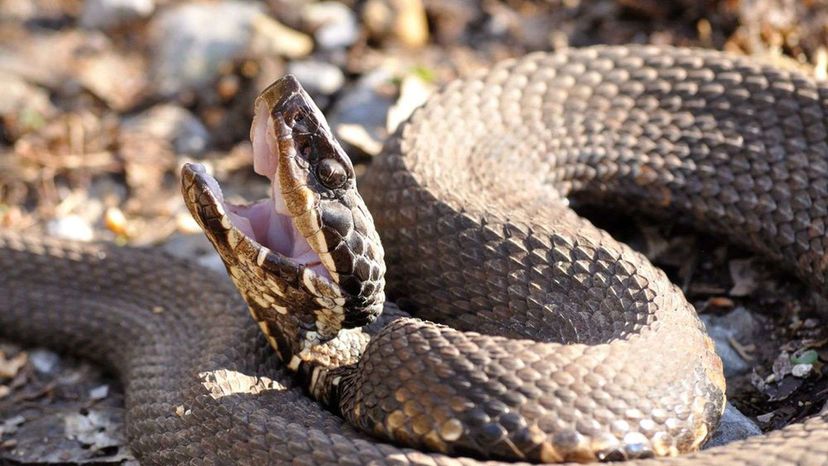
Like all pit vipers, the cottonmouth snake has two heat sensing pits, located between the eyes and the nostrils. These pits, which are sensitive to infrared light, allow the snake to pinpoint live prey and to strike without needing to physically see them. This hunting adaptation is particularly useful after dark, when most animals' bodies are warmer than the air around them.

The banded krait is not known to bite during the daytime. During night, however, it can be very vicious. Other snakes make up the largest part of their diet.

With an average length of seven feet (although they can regularly grow to ten feet), the South American bushmaster is the biggest viper and the longest snake with a venomous bite in the western hemisphere. It's found in South America and neighboring islands.
Advertisement

The Egyptian cobra, also referred to as Cleopatra's asp, is rumored to have gotten its name after Cleopatra likely committed suicide with the venom of the Egyptian cobra. If she, in fact, chose this as her method of suicide (which has never been proven) she likely chose this snake because it has unusually quick-acting, deadly venom.
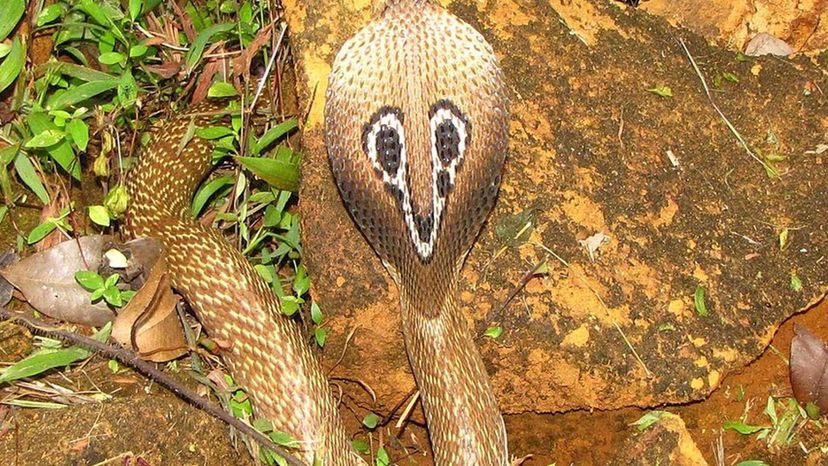
Spectacled cobras are also known as Indian cobras. They're an important part of Indian culture and mythology. Most people are familiar with these snakes as the subjects of snake charmers. These were also the same species as the snakes in the popular story, "Rikk-Tikki-Tavi," by Rudyard Kipling.
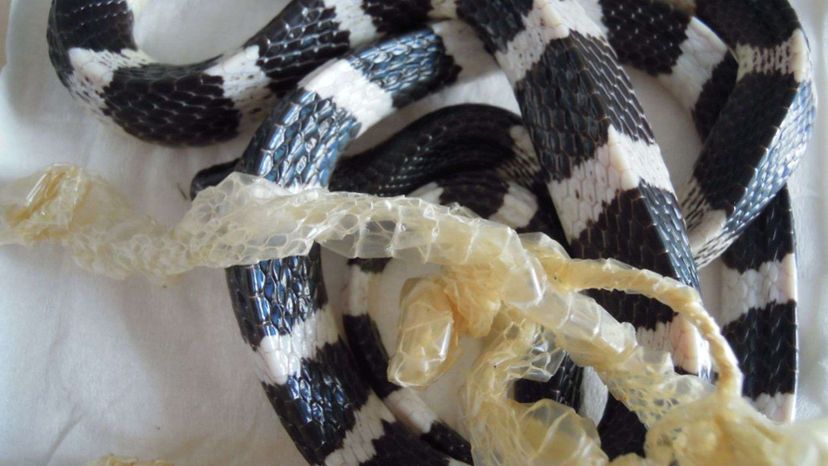
The Taiwanese/many-banded krait is a nocturnal snake, found throughout China and Southeast Asia. They tend to be defensive when it is dark; however, they are generally a timid and calm species. They tend to hide during the daytime, usually under stones or in holes. Hibernation occurs November through April.
Advertisement

Considered the most primitive of vipers, the Fea's Viper inhabits Myanmar, southeastern Tibet, southern China, and northern Vietnam. It has shorter fangs than those of other subfamilies and a somewhat flattened, golden head.

The coastal taipan lives in coastal regions of Australia and New Guinea. They spend a lot of time in the sugarcane fields. The coastal taipan tends to hunt in the morning, and uses a series of quick successive strikes to kill its prey.

The timber rattlesnake is a type of pit viper found in the eastern half the United States. Fun fact! The timber rattlesnake is the state reptile of West Virginia, and has been since 2008.
Advertisement

Speckled brown snakes are usually around four and half feet long. They eat a variety of small animals: frogs, lizards, birds and small mammals. Their venom is more toxic than Indian cobras.

The Mozambique spitting cobra can accurately spray venom up to 10 feet away. Their venom is predominately cytotoxic, causing serious tissue damage. It also causes neurotoxic effects on the central and peripheral nervous system.

The rough-scaled snake is found in isolated pockets of Coastal Queensland and Northern New South Wales. It feeds on frogs, small reptiles, and mammals. While it normally hunts on the ground, it can climb trees to chase after prey.
Advertisement
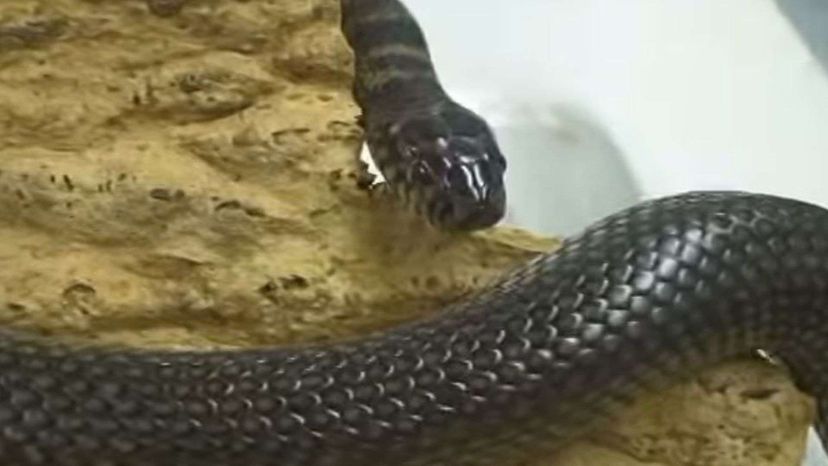
The Congo water cobra is semi-aquatic, and a very good swimmer. It's only found in a small region of central western Africa. It mostly eats amphibians and fish, but will also eat small terrestrial animals.

This species was named after Patrick Russell, the Scottish herpetologist that was the first scientist to describe many of the Indian snakes. The Russell's viper is a member of the "big four" snakes of India.

The red-bellied black snake was first scientifically described in the late eighteenth century. The venom of this snake is mild compared to other similar snakes, causing serious illness, but no deaths.
Advertisement

Even though the mulga snake tolerates the venom of other poisonous snakes and spiders (many of which it eats,) they can die after eating the poisonous cane toad. This type of toad is responsible for a drastic decline in the number of mulga snakes in the northern parts of Australia.
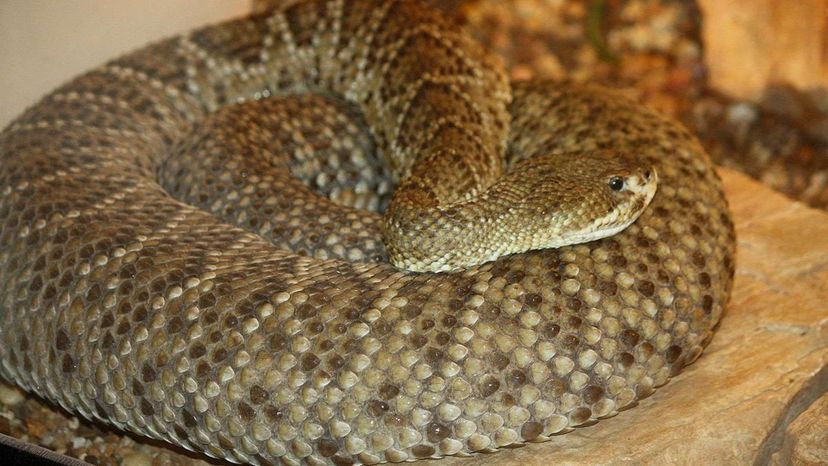
Also known as the Mexican green rattler or the Mexican west coast green rattlesnake, it's unsurprisingly found on the west coast of Mexico. The snakes are mostly red when they are juveniles, but turn green as adults.

Monocled cobras get their name from their O-shape hood pattern, also known as the monocellate hood pattern. They prefer habitats with water features like swamps and rice paddies.
Advertisement

The eastern brown snake is the second most-venomous terrestrial snake in the world. This Australian snake is responsible for roughly 60% of snake bite deaths in the country. They mostly eat small mammals (and other vertebrates) in the wild.

There are actually seven distinct species of death adders, and all of them are highly venomous. Without treatment, a death adder bite can kill a person in six hours. Fun fact! Death adders were originally called "deaf adders" because people thought they couldn't hear when they didn't appear to retreat at a threat. Now we know that they, like all terrestrial snakes, sense movement via ground vibrations.

Black mambas reside in sub-Saharan Africa. They can move up to 10mph and jump. This means that when they defend themselves against an encroaching human, the bites can actually be on the upper body, rather than the feet or legs.
Advertisement

The lowlands copperhead is the only venomous snake found to live higher than the snow line. It is active in weather that is colder than most snakes can tolerate. Copperheads love being around all types of water, including agricultural areas.

The inland taipan is the most venomous snake in the world. This Australian species is adapted to kill warm-blooded animals, and has enough toxins in a single bite to kill roughly 100 adult men. If left untreated, the mortality rate is greater than 80%. Despite it's highly toxic venom, the snake itself is rather calm and not aggressive.

The Chinese cobra is aggressive by nature, but also generally avoids people. They usually eat small animals, including other snakes. It's highly environmentally adaptable, and lives in a wide variety of habitats.
Advertisement

The northern Philippine cobra is capable of spitting venom up to three meters! The snakes usually eats a wide variety of small, terrestrial animals, but will sometimes go after birds.

Cobras spit by squeezing their venom glands, which pushes the venom into the fangs and out of the front holes. Spitting cobras have larger holes in their fangs than other venomous snakes, which squirt rather than ooze. If the venom gets in your eyes, it causes serious pain, and temporary (although sometimes permanent) blindness.

The Jararaca is found in South America. A peptide found in its venom was used in the development of ACE inhibitors, which are a medication class used for high blood pressure. The venom was also used to develop an anti-hemorrhagic drug.
Advertisement

Rinkhals are also called ringhals, which is derived from the Dutch word meaning "ringed neck." While they are sometimes called ring-necked spitting cobras, they are not true cobras. Their venom is milder than other, similar species.

The Jameson's mamba is highly arboreal, more so than other mamba species, and descends to the ground only in pursuit of prey. Because of it's tree-living lifestyle, it often eats birds, but it will also eat other small animals.

The Cape cobra is one of the most venomous African cobras. It's known locally, in South Africa, as the yellow snake. Surprisingly, this species is eaten by honey badgers, birds of prey and some species of mongoose.
Advertisement

Found in West Africa, the Mali cobra is a species of spitting cobra. It's habitat ranges from tropical grasslands to the savanna.

In Costa Rica, the Terciopelo is the considered the most dangerous snake, as they are responsible for almost half of all snake bites and one-third of all hospitalizations. They can be hard to see in their natural habitat, which makes them even more dangerous.